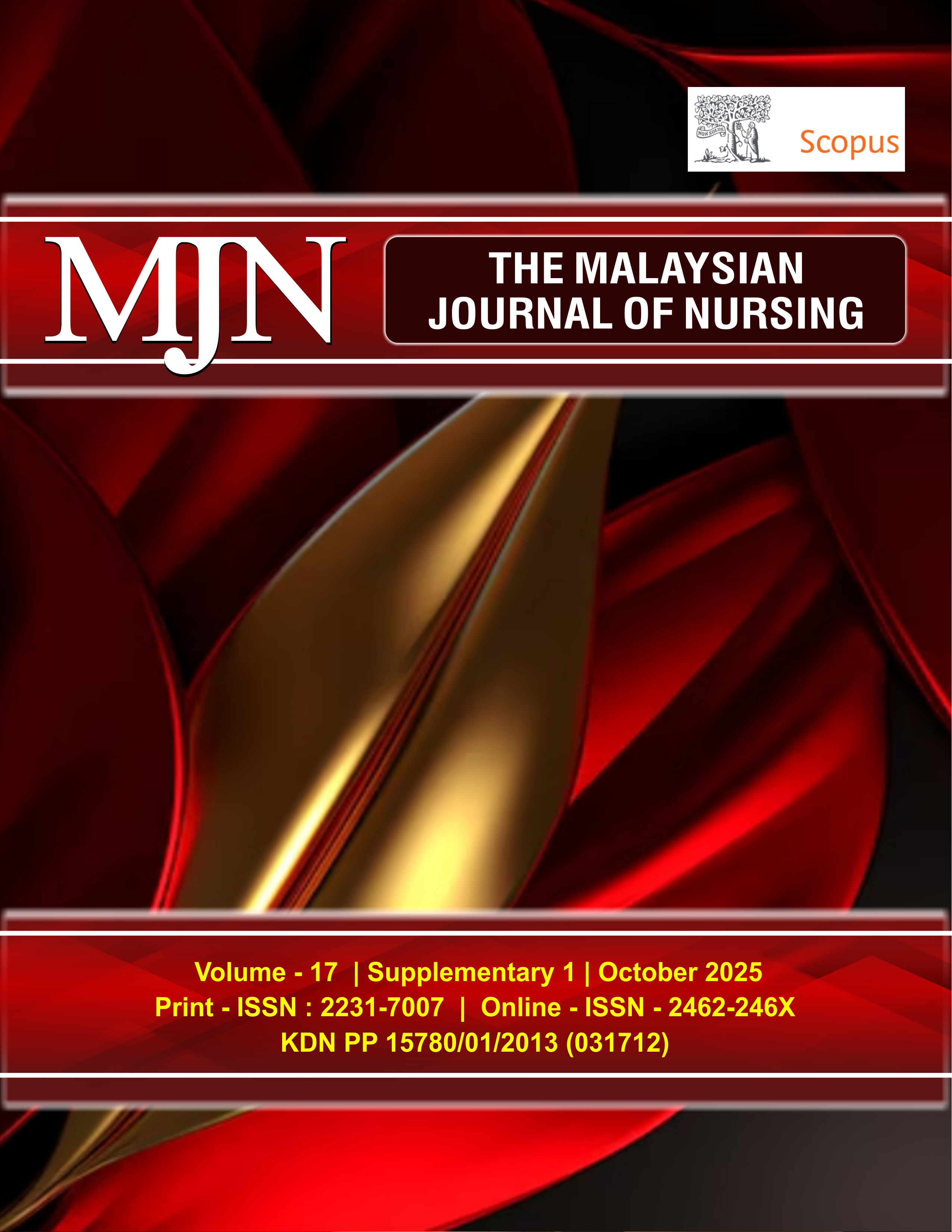Assessing Personality Traits among Adolescents in Secondary Schools: A Comprehensive Inventory Approach
DOI:
https://doi.org/10.31674/mjn.2025.v17isupp1.008Abstract
Background: For some young people, their maladaptive personality patterns may become severe enough to be diagnosed as personality disorders. For others, even if their maladaptive personality traits may not reach clinical significance, these problems probably still lead to difficulties in social adjustment and mental health. Objective: Assess personality traits in adolescents and identify their association with demographic variables. Methods: A descriptive cross-sectional study was conducted among 150 purposively selected secondary school students to assess personality traits using the Personality Inventory for the Diagnostic and Statistical manual of Mental Disorders, Fifth Edition – Brief Form (PID-5-BF) among children aged 11–17 years. Results: The overall score of the personality inventory is that 66.7% of adolescents have moderate dysfunction, as seen with a mean total score (M±SD= 29.16±7+.019). There is no evidence of the association between adolescents’ personalities and their sociodemographic variables. Conclusion: The overall personality inventory score of adolescents has moderate dysfunction. there was no substantial relationship between adolescent personality traits and demographic variables (age, gender, residence, education, occupation, and socio-economic status) in this study, although overall, the lives of adolescents were quite varied. Recommendation: These results encourage a shift toward a more individualised approach to understanding adolescent personality development, recognising the complex interplay of various influences beyond demographics. The study also recommends establishing educational programs for families, school administrations, and teachers as well on how to deal with adolescents and explaining this critical period in human life and its impact on shaping the individual’s future personality.
Keywords:
Adolescents, Assessment, Personal Inventory, Secondary SchoolsDownloads
References
Athar, M. E., & Ebrahimi, A. (2023). Validation of the Personality Inventory for DSM-5–Brief Form (PID-5-BF) with Iranian university students and clinical samples: Factor structure, measurement invariance, and convergent, discriminant, and known-groups validity. Journal of Personality Assessment, 105(3), 371-381. https://doi.org/10.1080/00223891.2022.2152347
Ayas, T., & Horzum, M. B. (2013). Relation between depression, loneliness, self-esteem, and internet addiction. Education, 133, 283–290. Retrieved from: https://scholar.google.com/scholar?hl=en&as_sdt=0%2C5&q=Ayas%2C+T.%3B+Horzum%2C+M.B.+Relation+between+Depression%2C+Loneliness%2C+Self-Esteem%2C+and+Internet+Addiction.+Education+2013%2C+133%2C+283%E2%80%93290&btnG=. Accessed on 14th August, 2023.
Bogaerts, A., Claes, L., Buelens, T., Verschueren, M., Palmeroni, N., Bastiaens, T., & Luyckx, K. (2021). Identity synthesis and confusion in early to late adolescents: Age trends, gender differences, and associations with depressive symptoms. Journal of Adolescence, 87, 106–116. https://doi.org/10.1016/j.adolescence.2021.01.006
Bozzato, P. (2024). The future orientation of Italian adolescents in post-pandemic times: Associations with self-efficacy and perceived academic achievement. Education Sciences, 14(2). https://doi.org/10.3390/educsci14020170
Cattelino, E., Testa, S., Calandri, E., Fedi, A., Gattino, S., Graziano, F., ... & Begotti, T. (2023). Self-efficacy, subjective well-being and positive coping in adolescents during Covid-19 lockdown. Current Psychology, 42(20), 17304–17315. https://doi.org/10.1007/s12144-021-01965-4
Charlton, J. P., & Danforth, I. D. (2010). Validating the distinction between computer addiction and engagement: Online game playing and personality. Behavior & Information Technology, 29(6), 601–613. https://doi.org/10.1080/01449290903401978
Crosnoe, R., & Thorpe, J. (2022). Twenty-five years of national-level research on adolescent and young adult mental health in the United States. Journal of Adolescent Health, 71(6), S40–S46. https://doi.org/10.1016/j.jadohealth.2022.08.008
Deryakulu, D., & Ursavaş, Ö. F. (2014). Genetic and environmental influences on problematic Internet use: A twin study. Computers in Human Behavior, 39, 331–338. https://doi.org/10.1016/j.chb.2014.07.038
Dunne, A. L., Trounson, J. S., Skues, J., Pfeifer, J. E., Ogloff, J. R., & Daffern, M. (2021). The Personality Inventory for DSM-5–Brief Form: An examination of internal consistency, factor structure, and relationship to aggression in an incarcerated offender sample. Assessment, 28(4), 1136-1146. https://doi.org/10.1177/1073191120916790
Geffner, R., Conradi, L., Geis, K., & Aranda, M. B. (2009). Conducting child custody evaluations in the context of family violence allegations: Practical techniques and suggestions for ethical practice. Journal of Child Custody, 6(3–4), 189–218. https://doi.org/10.1080/15379410903084608
Haehner, P., Kritzler, S., & Luhmann, M. (2024). Individual differences in changes in subjective well-being: The role of event characteristics after negative life events. Journal of Personality and Social Psychology, 127(3), 702–729. https://doi.org/10.1037/pspp0000511
Halat, D. H., Soltani, A., Dalli, R., Alsarraj, L., & Malki, A. (2023). Understanding and fostering mental health and well-being among university faculty: A narrative review. Journal of Clinical Medicine, 12(13). https://doi.org/10.3390/jcm12134425
Herrera-Gutiérrez, E., Gómez-Amor, J., López-Ortuño, J., Navarro-Noguera, M., & Villanueva-Blasco, V. J. (2021). Cognitive and personality differences between adolescents with and without attention-deficit/hyperactivity disorder. Acta Psychologica, 219. https://doi.org/10.1016/j.actpsy.2021.103386
Ji, M., Qi, Y., Tu, H., Wu, S., & Wang, X. (2025). The influence of negative events on adolescents’ mobile phone addiction: The chain mediating role of personality traits and emotional regulation style. Frontiers in Psychiatry, 16. https://doi.org/10.3389/fpsyt.2025.1530212
Kim, J. (2022). Personality, health behaviors and physical health in young adulthood. Psychology & Health, 37(9), 1164–1183. https://doi.org/10.1080/08870446.2021.1934468
Kumar, S., & Voracek, M. (2022). The relationships of family income and caste-status with religiousness: Mediation role of intolerance of uncertainty. PLoS One, 17(8). https://doi.org/10.1371/journal.pone.0273174
Li, H., Xiao, B., & Song, G. (2024). The impact of family socioeconomic status (SES) on adolescents’ learning conformity: The mediating effect of self-esteem. Children, 11(5). https://doi.org/10.3390/children11050540
Meehan, M. L. (1993). West Virginia Adolescents' Health Risk Behaviors: Differences by Gender, Age, Grade Level, and Level of Rurality. Education Resources Information Center (ERIC). Retrieved from: https://files.eric.ed.gov/fulltext/ED360134.pdf
Müller, K. W., Dreier, M., Beutel, M. E., Duven, E., Giralt, S., & Wölfling, K. (2016). A hidden type of internet addiction? Intense and addictive use of social networking sites in adolescents. Computers in Human Behavior, 55, 172–177. https://doi.org/10.1016/j.chb.2015.09.007
Porcerelli, J. H., Hopwood, C. J., & Jones, J. R. (2019). Convergent and discriminant validity of Personality Inventory for DSM-5-BF in a primary care sample. Journal of Personality Disorders, 33(6), 846-856. https://doi.org/10.1521/pedi_2018_32_372
Randler, C., Horzum, M. B., & Vollmer, C. (2014). Internet addiction and its relationship to chronotype and personality in a Turkish university student sample. Social Science Computer Review, 32(4), 484–495. https://doi.org/10.1177/0894439313511055
Ringwald, W. R., Napolitano, C. M., Sewell, M. N., Soto, C. J., Yoon, H. J., & Wright, A. G. (2025). More skill than trait, or more trait than skill? Relations of (mis)matches between personality traits and social, emotional, and behavioral skills with adolescent outcomes. European Journal of Personality. Advance Online Publication. https://doi.org/10.1177/08902070241309960
Sellbom, M., Wygant, D. B., & Drislane, L. E. (2015). Elucidating the construct validity of the psychopathic personality inventory triarchic scales. Journal of Personality Assessment, 97(4), 374–381. https://doi.org/10.1080/00223891.2014.962654
Urbán, D. J., La Greca, A. M., García-Fernández, J. M., & Ingles, C. J. (2024). A bibliometric analysis on adolescent social anxiety and psychoeducational variables in Web of Science 2002–2021. The Journal of General Psychology, 151(1), 1–20. https://doi.org/10.1080/00221309.2022.2161982
Wang, L., Luo, J., Bai, Y., Kong, J., Gao, W., & Sun, X. (2013). Internet addiction of adolescents in China: Prevalence, predictors, and association with well-being. Addiction Research & Theory, 21(1). https://doi.org/10.3109/16066359.2012.690053
Watson, D., Clark, L. A., Simms, L. J., & Kotov, R. (2022). Classification and assessment of fear and anxiety in personality and psychopathology. Neuroscience & Biobehavioral Reviews, 142, 104878. https://doi.org/10.1016/j.neubiorev.2022.104878
Published
How to Cite
Issue
Section
License
Copyright (c) 2025 The Malaysian Journal of Nursing (MJN)

This work is licensed under a Creative Commons Attribution-NonCommercial-NoDerivatives 4.0 International License.



































